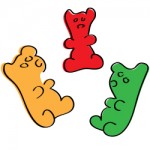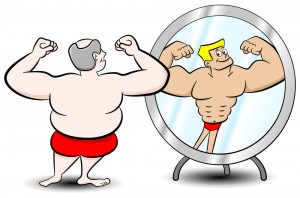“Science in a Bag” activities are various types of quick science experiments with different topics and purposes. These experiments should be easy to perform, very low cost, have quick instructions, and a great to keep students engaged and learning. The idea behind a “Science in a Bag” activity is to be economically and environmentally friendly, and to keep with the tight budget teachers always have. These activities are easy to transport since all the materials should fit in a Ziploc bag. Having these “Science in a Bag” experiments on hand as a TOC can be a great addition to save a scary classroom. They are great tricks for teachers to have up their sleeves to keep students busy.
Download the full version here: Science in a Bag Activities
Activity 1: Highlighter Gummy Bear

Purpose: To see the effects of light reflection and absorption using two different wavelengths of light (green and red)
Instructions:
- Set up the 2 red gummy bears beside each other and the 2 green gummy bears beside each other on top of a white piece of paper.
- Take the red laser pointer (button 1) and shine it on any one of the red gummy bears. Hold the laser pointer parallel to the paper and right against the bear. What do you notice about the gummy bear?
- Take the red laser pointer and shine it on a green gummy bear in the same way. What do you notice about the gummy bear?
- Switch the pointer to the white light. (button 2)
- Shine the white light on the red gummy bear, making sure you hold the light right against the bear. What do you notice about the gummy bear?
- Now shine it on the green gummy bear. What do you notice about the gummy bear?
- Compare your findings of the red light to the white light, based on what you saw on each colour of gummy bear.
Materials:
- White paper (computer paper)
- Red gummy bear (x2)
- Green gummy bear (x2)
- Red laser pointer
- White LED light pointer
Explanation:
The gummy bears glow depending on the type of light that is being shone. Only certain wavelengths of light can be absorbed or reflected by each gummy bear.
The red colour from the red laser pointer has a certain wavelength of light. This wavelength of light is reflected by the red gummy bear or the colour red. That is why the gummy bear appears to glow. The colour red of any red object will reflect red light. It will absorb all other colours or wavelengths of light.
The red laser pointer does not make the green gummy bear glow. This is because the green colour of the gummy bear absorbs red light. The green gummy bear will absorb all other wavelengths of light, except for green light. This makes the colour green appears.
Colours appear by the wavelength of light they reflect. Colours that you cannot see are absorbed by the object. For example, if an object reflects the wavelength of the colour orange, the object will appear orange. All other colours will be absorbed by the orange object, therefore not seen.
The white light is interesting because it makes both gummy bears glow. The white light contains all the colours. Therefore, each bear is able to reflect its own colour. This means that red reflects red from the white light and green reflects green. The red gummy bear absorbs all the other colours from the white light and the green absorbs all other colours except green.
Watch the video below for a demonstration:
Activity 2: Cartesian Diver
Purpose: to examine the effects of pressure and density in a contained system
Materials:
- 1 L or 2 L plastic bottle filled to the top with water
- Eye dropper filled half way with water
Instructions:
- Fill the plastic water bottle with water to the top
- Take the eye dropper and fill it half way with water
- Put the eye dropper in the water bottle and tighten the lid shut
- The eye dropper should be floating at the top of the bottle
Watch this YouTube video for a demonstration:
Download the full version below
Activity 3: Concave and Convex Mirrors

Purpose: to see the effects and uses of convex and concave mirrors
Materials:
- Small mirrors (from the dollar store)
Instructions:
- Hold the mirror in the sides and bend the edges towards you. What do you notice?
- Now bend the sides away from you. What do you notice?
- Compare your results from number 1 and number 2.
Download the full version below
Activity 4: The Black Box
Purpose: to investigate and use the scientific method to determine the contents in a black box
*Note: this experiment provokes curiosity and investigation among students; students can be as creative as they wish which keeps them engaged and interested
**as a teacher you can put anything you wish into the “black box” for students to examine and predict
Materials:
- Opaque film canister – black or dark coloured
- Cotton ball
- Paper clip
- Bead
- Staple
Materials may vary as you wish
Download the full version below
Activity 5: Static Combs
Purpose: to determine the effects of static electricity and explain electron movement
Materials:
- Plastic comb (dollar store)
- Small piece of cloth
- Three hole punch paper rounds
Instructions:
- Rub the plastic comb aggressively with the cloth for at least 30 seconds
- Bring the plastic comb close to long hair
- Observe the results
- Put the paper rounds on the table
- Rub the plastic comb aggressively with the cloth for at least 30 seconds again
- Bring the plastic comb to the hole punch paper rounds
- Observe what happens

Download the full version below
Download: Science in a Bag Activities

Title: Growing Beans in a Bag (Plant Germination)
Concept: How Plants Grow
Materials: Ziplock bag, damp paper towel, bean seeds
Instructions:
1. Place a damp paper towel inside the bag.
2. Put 2-3 beans between the towel and the bag.
3. Seal and tape the bag to a sunny window.
4. Check daily—roots and sprouts will appear in a few days!
Thinking: Seeds need water and warmth to germinate, even without soil.